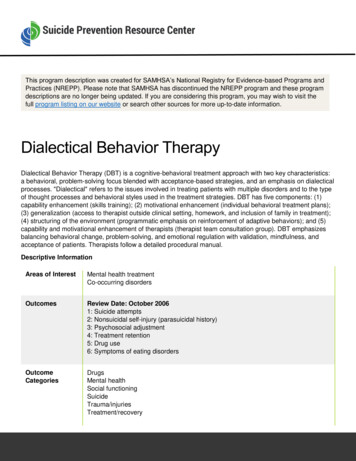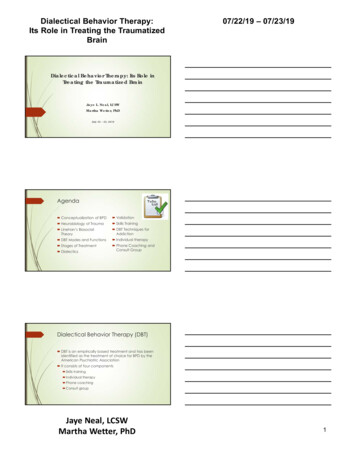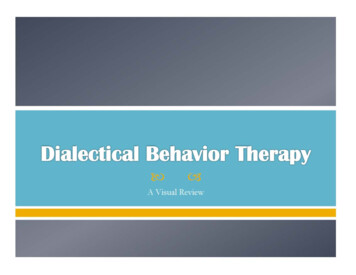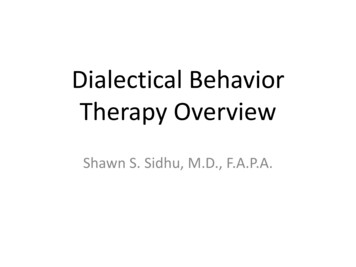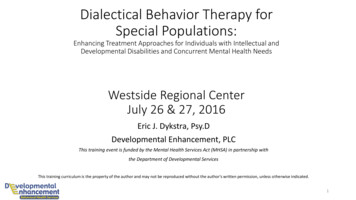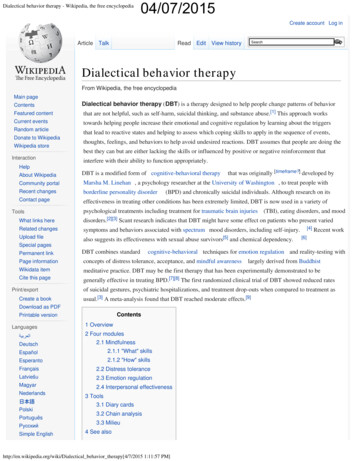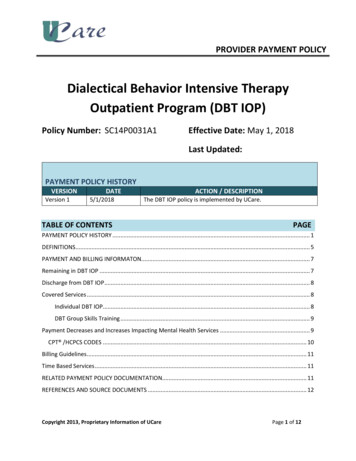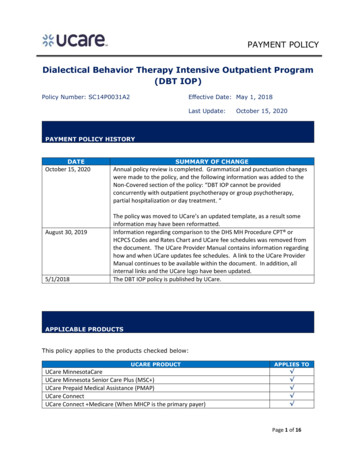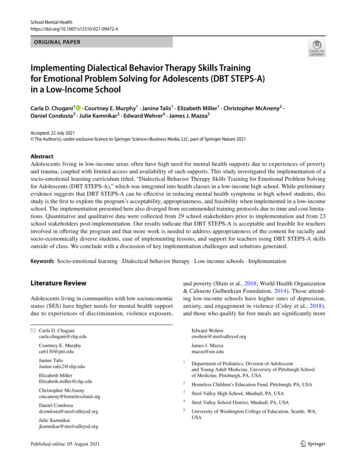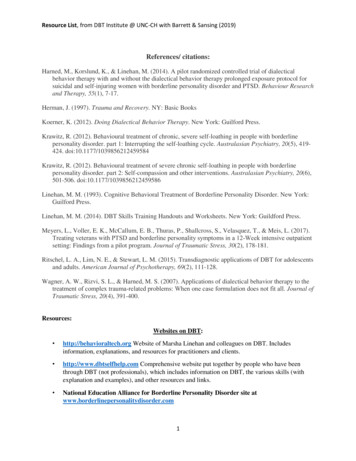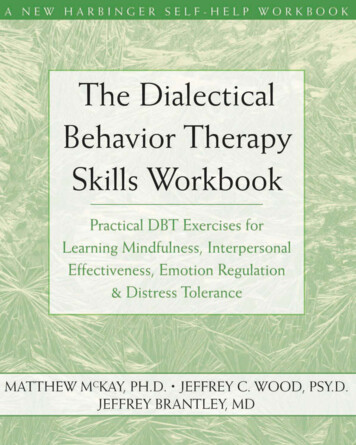
Transcription
The individual struggling with overwhelming emotions and DBT therapists will benefit significantly fromthis workbook. McKay, Wood and Brantley have expanded and translated DBT Skills, making Linehan’siconic work on emotional skill building even more accessible and easy to apply to everyday life.—Kate Northcott, MA, MFT, is a DBT therapist in private practice withMindfulness Therapy Associates and is director of New Perspectives Centerfor Counseling, a non-profit counseling center, in San Francisco, CA
The DialecticalBehavior TherapySkills WorkbookPractical DBT Exercises forLearning Mindfulness, InterpersonalEffectiveness, Emotion Regulation& Distress ToleranceMATTHEW MCKAY, PH.D. JEFFREY C. WOOD, PSY.D.JEFFREY BRANTLEY, MDNew Harbinger Publications, Inc.
Publisher’s NoteThis publication is designed to provide accurate and authoritative information in regard to the subject matter covered. Itis sold with the understanding that the publisher is not engaged in rendering psychological, financial, legal, or other professional services. If expert assistance or counseling is needed, the services of a competent professional should be sought.Distributed in Canada by Raincoast BooksCopyright 2007 by Matthew McKay, Jeffrey C. Wood, and Jeffrey BrantleyNew Harbinger Publications, Inc.5674 Shattuck AvenueOakland, CA 94609www.newharbinger.comAll Rights ReservedPrinted in the United States of AmericaAcquired by Catharine Sutker; Cover design by Amy Shoup;Edited by Elisabeth Beller; Text design by Tracy CarlsonLibrary of Congress Cataloging-in-Publication DataThe dialectical behavior therapy skills workbook : practical DBT exercises for learning mindfulness, interpersonaleffectiveness, emotion regulation, and distress tolerance / Matthew McKay . [et al.].p. cm.ISBN-13: 978-1-57224-513-6ISBN-10: 1-57224-513-11. Dialectical behavior therapy--Problems, exercises, etc. I. McKay, Matthew.RC489.B4D52 2007616.89’142--dc22200701300709 08 0710 9 8 7 6 5 4 3 2 1First printing
In memory of my mother, Louise Long LaBrash, who was always there for me in the hard times.—Matthew McKayTo my students and clients at Fresno City College and Reedley College, 2005–2006, whosestrength, hope, and resilience inspired me while writing this book.—Jeffrey C. WoodThis work is dedicated to all who struggle with intense and unpredictable emotions in theirinner and outer lives. May you find peace and happiness, and may all living beings benefit fromyour efforts.—Jeffrey Brantley
ContentsIntroduc tionDialectical Behavior Therapy: An Overview of the Treatment. . . . . . . . . . . . . 1C h a p ter 1Basic Distress Tolerance Skills . . . . . . . . . . . . . . . . . . . . . . . . . . . . . . . . . . . . . . 5C h a p ter 2Advanced Distress Tolerance Skills: Improve the Moment. . . . . . . . . . . . . . . 31C h a p ter 3Basic Mindfulness Skills. . . . . . . . . . . . . . . . . . . . . . . . . . . . . . . . . . . . . . . . . . . 63C h a p ter 4Advanced Mindfulness Skills . . . . . . . . . . . . . . . . . . . . . . . . . . . . . . . . . . . . . . . 85C h a p ter 5Exploring Mindfulness Further . . . . . . . . . . . . . . . . . . . . . . . . . . . . . . . . . . . . 115C h a p ter 6Basic Emotion Regulation Skills. . . . . . . . . . . . . . . . . . . . . . . . . . . . . . . . . . . . 121C h a p ter 7Advanced Emotion Regulation Skills. . . . . . . . . . . . . . . . . . . . . . . . . . . . . . . . 159C h a p ter 8Basic Interpersonal Effectiveness Skills. . . . . . . . . . . . . . . . . . . . . . . . . . . . . . 181
C h a p ter 9Advanced Interpersonal Effectiveness Skills. . . . . . . . . . . . . . . . . . . . . . . . . . 199C h a p ter 10Putting It All Together . . . . . . . . . . . . . . . . . . . . . . . . . . . . . . . . . . . . . . . . . . . 225References. . . . . . . . . . . . . . . . . . . . . . . . . . . . . . . . . . . . . . . . . . . . . . . . . . . . 229vi The Dialectical Behavior Therapy Skills Workbook
Introduc tionDialectical Behavior Therapy:An Overview of the TreatmentDialectical behavior therapy, developed by Marsha Linehan (1993a, 1993b), is extraordinarilyeffective at helping people manage overwhelming emotions. Research shows that dialecticalbehavior therapy strengthens a person’s ability to handle distress without losing control or actingdestructively.A lot of people struggle with overwhelming emotions. It’s as if the knob is turned to maximumvolume on much of what they feel. When they get angry or sad or scared, it shows up as a big,powerful wave that can sweep them off their feet.If you’ve faced overwhelming emotions in your life, you know what we’re talking about. Thereare days when your feelings hit you with the force of a tsunami. And when that happens, it makesyou—understandably—afraid to feel things because you don’t want to get swept away by youremotions. The trouble is, the more you try to suppress or put a lid on your emotions, the moreoverwhelming they can get. We’ll talk about that in chapters 6 and 7 on emotional regulation.What’s important to know right now is that trying to stop your feelings doesn’t work.There’s a fair amount of research to suggest that the likelihood of developing intense, overwhelming emotions may be hardwired from birth. But it can also be greatly affected by traumaor neglect during childhood. Trauma at critical points in our development can literally alter ourbrain structure in ways that make us more vulnerable to intense, negative emotions. However, thefact that a propensity to intense emotions is often rooted in genetics or trauma doesn’t mean theproblem can’t be overcome. Thousands of people have used the skills you’ll learn in this book toachieve better emotional control. They have changed their lives—and you can too.So what are these skills, and how will they help you? Dialectical behavior therapy teachesfour critically important skills that can both reduce the size of emotional waves and help you keepyour balance when those emotions overwhelm you.
1.Distress tolerance will help you cope better with painful events by building up yourr esiliency and giving you new ways to soften the effects of upsetting circumstances.2.Mindfulness will help you experience more fully the present moment while focusingless on painful experiences from the past or frightening possibilities in the future.Mindfulness will also give you tools to overcome habitual, negative judgments aboutyourself and others.3.Emotion regulation skills help you to recognize more clearly what you feel and then toobserve each emotion without getting overwhelmed by it. The goal is to modulate yourfeelings without behaving in reactive, destructive ways.4.Interpersonal effectiveness gives you new tools to express your beliefs and needs, set limits,and negotiate solutions to problems—all while protecting your relationships and treatingothers with respect.This book is structured to make learning easier. Each of the key skills is covered in two chapters—basic and advanced—except mindfulness, which has a third, more advanced chapter. Thebasic skills chapters teach necessary concepts, identify the components of the new skill, and leadyou through initial steps for acquiring the skill. The advanced skills chapters take you through theremaining components of the skill, building level by level. There will be examples to make eachstep clear as well as assessments, exercises, and worksheets to help you practice each thing youlearn. Then in the final chapter, Putting It All Together, you’ll learn how to integrate all thoseskills, in order to make them a regular part of your life.The Dialectical Behavior Therapy Skills Workbook is written to make learning easy. The hardpart will be making the commitment to do the exercises and put your new skills into practice.Nothing will change by just reading. The words on these pages will have no impact on your lifeunless you implement—behaviorally—the new techniques and strategies you will learn here. Sonow is a good time to think about why you are reading this book and what you want to change.Right here, on this page, write down three ways you currently react to your emotions that youwant to change. In other words, what three things do you do when upset or overwhelmed that aredamaging—and that you are committed to replace with better ways to cope?1.2.3.2 The Dialectical Behavior Therapy Skills Workbook
Who This Book Is ForThere are two intended audiences for The Dialectical Behavior Therapy Skills Workbook. The first ispeople who are in dialectical behavior therapy (either group or individual) and need a workbook tohelp learn the four key skills. We also wrote this book so it could be used independently by anyonewho struggles with overwhelming feelings. All the tools are here to achieve significant changes inyour ability to control emotion. With that said, if you are reading this workbook on your own andare having a hard time implementing the new skills, we strongly recommend seeking the servicesof a qualified dialectical behavior therapist.There Is HopeLife is hard. You already know that. But you are not stuck or helpless in your struggle with youremotions. You can expect, if you really do the work to implement these skills, that how you react tofeelings will change. That’s because—regardless of genetics or early pain—the key skills you’ll learnhere can affect the outcome of every conflict and every upset and can literally alter the course ofyour relationships. There is every reason to hope. All you have to do is turn the page and begin.Then keep working at it.Dialectical Behavior Therapy: An Overview of the Treatment 3
Chapter 1Basic Distress Tolerance SkillsDistress Tolerance Skills: What Are They?At some point in our lives, we all have to cope with distress and pain. Either it can be physical,like a bee sting or a broken arm, or it can be emotional, like sadness or anger. In both cases, thepain is often unavoidable and unpredictable. You can’t always anticipate when the bee will stingyou or when something will make you sad. Often, the best you can do is to use the coping skillsthat you have and hope that they work.But for some people, emotional and physical pain feels more intense and occurs more frequently than it does for other people. Their distress comes on more quickly and feels like anoverwhelming tidal wave. Often, these situations feel like they’ll never end, and the people experiencing them don’t know how to cope with the severity of their pain. For the purposes of thisbook, we’ll call this problem overwhelming emotions. (But remember, emotional and physical painoften occur together.)People struggling with overwhelming emotions often deal with their pain in very unhealthy,very unsuccessful ways because they don’t know what else to do. This is understandable. When aperson is in emotional pain, it’s hard to be rational and to think of a good solution. Nevertheless,many of the coping strategies used by people with overwhelming emotions only serve to make theirproblems worse.Here’s a list of some common coping strategies used by people dealing with this problem.Check ( ) the ones that you use to cope with your stressful situations: You spend a great deal of time thinking about past pains, mistakes, and problems. You get anxious worrying about possible future pains, mistakes, and problems.You isolate yourself from other people to avoid distressing situations.
You make yourself feel numb with alcohol or drugs. You take your feelings out on other people by getting excessively angry at them ortrying to control them. You engage in dangerous behaviors, such as cutting, hitting, picking at, or burningyourself or pulling out your own hair. You engage in unsafe sexual activities, such as having sex with strangers or havingfrequent unprotected sex. You avoid dealing with the causes of your problems, such as an abusive ordysfunctional relationship. You use food to punish or control yourself by eating too much, not eating at all, orby throwing up what you do eat. You attempt suicide or engage in high-risk activities, like reckless driving or takingdangerous amounts of alcohol and drugs. You avoid pleasant activities, such as social events and exercise, maybe because youdon’t think that you deserve to feel better. You surrender to your pain and resign yourself to living a miserable and unfulfillinglife.All of these strategies are paths to even deeper emotional pain, because even the strategies that offer temporary relief will only cause you more suffering in the future. Use the Cost ofSelf-Destructive Coping Strategies worksheet to see how. Note the strategies that you use as wellas their costs, and then include any additional costs that you can think of. At the end of the worksheet, feel free to add any of your own strategies that aren’t included as well as their costs.6 The Dialectical Behavior Therapy Skills Workbook
The Cost of Self-Destructive Coping StrategiesSelf-Destructive Coping StrategyPossible Costs1.You spend a great deal of time thinkingabout past pain, mistakes, and problems.Miss good things that might be happeningnow and then regret missing those things,too; depression about the pastOther:2.You get anxious worrying about possiblefuture pain, mistakes, and problems.Miss good things that might be happeningnow; anxiety about the futureOther:3.You isolate yourself to avoid possiblepain.Spend more time alone and, as a result, feeleven more depressedOther:4.You use alcohol and drugs to numbyourself.Addiction; loss of money; work problems;legal problems; relationship problems; healthconsequencesOther:5.You take your painful feelings out onothers.Loss of friendships, romantic relationships,and family members; other people avoidyou; loneliness; feel bad about hurting otherpeople; legal consequences of your actionsOther:6.You engage in dangerous behaviors,like cutting, pulling out hair, andself-mutilation.Possible death; infection; scarring;disfigurement; shame; physical painOther:Basic Distress Tolerance Skills 7
7.You engage in unsafe sexual activity, like Sexually transmitted diseases, some life threatenunprotected sex or frequent sex withing; pregnancy; shame; embarrassmentstrangers.Other:8.You avoid dealing with the causes ofyour problems.Put up with destructive relationships; getburned-out doing things for other people;don’t get any of your own needs met;depressionOther:9.You eat too much, restrict what you eat,or throw up what you eat.Weight gain; anorexia; bulimia; healthconsequences; medical treatment;embarrassment; shame; depressionOther:10. You have attempted suicide or engagedin other nearly fatal activities.Possible death; hospitalization;embarrassment; shame; depression;long-term medical complicationsOther:11. You avoid pleasant activities, like socialevents and exercise.Lack of enjoyment; lack of exercise;depression; shame; isolationOther:12. You surrender to your pain and live anunfulfilling life.Lots of pain and distress; regrets about yourlife; depressionOther:13.14.8 The Dialectical Behavior Therapy Skills Workbook
The costs of these self-destructive coping strategies are clear. All of them lead to your painbeing prolonged into long-term suffering. Remember, sometimes pain can’t be avoided, but manytimes suffering can.Take, for example, an argument between friends Maria and Sandra. For Maria, who doesn’thave overwhelming emotions, the argument was initially painful. But after a few hours, she beganto realize that she and Sandra were both to blame for the argument. So by the next day, Mariawas no longer upset or mad at Sandra. But for Sandra, who struggles with overwhelming emotions, the argument was replayed in her memory over and over again for three days. Each wordand gesture was remembered as an insult from Maria. So the next time Sandra saw Maria, threedays later, Sandra was still angry and she restarted the argument just where it had ended. Bothwomen experienced the initial pain of the argument, but only Sandra was suffering. Clearly, Sandracarried her emotional pain with her for days, and it made her life more of a struggle. While we can’talways control the pain in our lives, we can control the amount of suffering we have in responseto that pain.To avoid this type of long-term suffering, chapters 1 and 2 will teach you distress toleranceskills. These skills will help you endure and cope with your pain in a new, healthier way so that itdoesn’t lead to suffering. The new plan outlined in these two chapters will teach you to “distract,relax, and cope.”About This ChapterThe first distress tolerance skills you’ll learn in this chapter will help you distract yourself from thesituations that are causing you emotional pain. Distraction skills are important because (1) theycan temporarily stop you from thinking about your pain and, as a result, (2) they give you time tofind an appropriate coping response. Remember how Sandra carried her pain with her for threedays? She couldn’t stop thinking about her argument with Maria. Distraction can help you let goof the pain by helping you think about something else. Distraction also buys you time so that youremotions can settle down before you take action to deal with a distressing situation.However, do not confuse distraction with avoidance. When you avoid a distressing situation,you choose not to deal with it. But when you distract yourself from a distressing situation, you stillintend to deal with it in the future, when your emotions have calmed down to a tolerable level.The second group of distress tolerance skills you’ll learn in this chapter are self- soothingskills (Johnson, 1985; Linehan, 1993b). It’s often necessary to soothe yourself before you face thecause of your distress because your emotions might be too “hot.” Many people with overwhelmingemotions panic when faced with an argument, rejection, failure, or other painful events. Beforeyou can address these problems with your new emotion regulation skills (chapters 6 and 7) or yournew interpersonal effectiveness skills (chapters 8 and 9), it’s often necessary to soothe yourself toregain your strength. In situations like these, distress tolerance skills are similar to refilling the gasin your car so that you can keep going. Self-soothing is meant to bring you some amount of peaceand relief from your pain so that you can figure out what you’re going to do next.Basic Distress Tolerance Skills 9
Self-soothing skills also serve another purpose. They’ll help you learn to treat yourself compassionately. Many people with overwhelming emotions have been abused or neglected as children.As a result, they were taught more about how to hurt than to help themselves. The second purposeof the self-soothing skills, therefore, is to teach you how to treat yourself kindly and lovingly.How to Use This ChapterAs you read the following groups of skills, mark the ones that are helpful to you. This will makeit easier to create a distraction plan for emergencies when you get to the end of this chapter. You’llalso be shown how to create a list of relaxation skills to help soothe yourself, both at home andwhen you’re away. Then, in the next chapter, you’ll learn more advanced distress tolerance skills.Radical AcceptanceIncreasing your ability to tolerate distress starts with a change in your attitude. You’re going to needsomething called radical acceptance (Linehan, 1993a). This is a new way of looking at your life. Inthe next chapter, you’ll be given some key questions to help you examine your experiences usingradical acceptance. But for now, it will be sufficient to cover this concept briefly.Often, when a person is in pain, his or her first reaction is to get angry or upset or to blamesomeone for causing the pain in the first place. But unfortunately, no matter who you blame foryour distress, your pain still exists and you continue to suffer. In fact, in some cases, the angrieryou get, the worse your pain will feel (Greenwood, Thurston, Rumble, Waters, & Keefe, 2003;Kerns, Rosenberg, & Jacob, 1994).Getting angry or upset over a situation also stops you from seeing what is really happening.Have you ever heard the expression “being blinded by rage”? This often happens to people withoverwhelming emotions. Criticizing yourself all the time or being overly judgmental of a situation islike wearing dark sunglasses indoors. By doing this, you’re missing the details and not seeing everything as it really is. By getting angry and thinking that a situation should never have happened,you’re missing the point that it did happen and that you have to deal with it.Being overly critical about a situation prevents you from taking steps to change that situation. You can’t change the past. And if you spend your time fighting the past—wishfully thinkingthat your anger will change the outcome of an event that has already happened—you’ll becomeparalyzed and helpless. Then, nothing will improve.So, to review—being overly judgmental of a situation or overly critical of yourself often leadsto more pain, missed details, and paralysis. Obviously, getting angry, upset, or critical doesn’timprove a situation. So what else can you do?The other option, which radical acceptance suggests, is to acknowledge your present situation,whatever it is, without judging the events or criticizing yourself. Instead, try to recognize that yourpresent situation exists because of a long chain of events that began far in the past. For example,10 The Dialectical Behavior Therapy Skills Workbook
some time ago, you (or someone else) thought you needed help for the emotional pain you wereexperiencing. So, a few days later, you went to the bookstore and bought this book. Then todayyou thought about reading this chapter, and eventually you sat down, opened the book, and beganreading. Now, you are up to the words you see here. Denying this chain of events does nothing tochange what has already happened. Trying to fight this moment or say that it shouldn’t be onlyleads to more suffering for you. Radical acceptance means looking at yourself and the situationand seeing it as it really is.Keep in mind that radical acceptance does not mean that you condone or agree with badbehavior in others. But it does mean that you stop trying to change what’s happened by gettingangry and blaming the situation. For example, if you’re in an abusive relationship and you need toget out, then get out. Don’t waste your time and continue to suffer by blaming yourself or the otherperson. That won’t help you. Refocus your attention on what you can do now. This will allow youto think more clearly and figure out a better way to cope with your suffering.Radical Acceptance Coping StatementsTo help you begin using radical acceptance, it’s often helpful to use a coping statement toremind yourself. Below are a few examples and spaces to create your own. Check ( ) the statements that you would be willing to use to remind yourself that you should accept the presentmoment and the chain of events that created it. Then, in the next exercise, you’ll begin using thestatements that you chose.“This is the way it has to be.”“All the events have led up to now.”“I can’t change what’s already happened.”“It’s no use fighting the past.”“Fighting the past only blinds me to my present.”“The present is the only moment I have control over.”“It’s a waste of time to fight what’s already occurred.”“The present moment is perfect, even if I don’t like what’s happening.”“This moment is exactly as it should be, given what’s happened before it.”“This moment is the result of over a million other decisions.”Other ideas:Basic Distress Tolerance Skills 11
Exercise: Radical AcceptanceNow, using the coping statements that you checked, begin radically accepting different momentsin your life without judging them. Naturally, it will be difficult to accept very painful situations,so start with smaller events. Here are some suggestions. Check ( ) the ones you’re willing to do,and add any of your own ideas. Then use your coping statements to radically accept the situationwithout being judgmental or critical. Read a controversial story in the newspaper without being judgmental about what hasoccurred.The next time you get caught in heavy traffic, wait without being critical.Watch the world news on television without being critical of what’s happening. Listen to a news story or a political commentary on the radio without beingjudgmental. Review a nonupsetting event that happened in your life many years ago, and useradical acceptance to remember the event without judging it.Other ideas:Distract Yourself fromSelf-Destructive BehaviorsOne of the most important purposes of dialectical behavior therapy is to help you stop engaging inself-destructive behaviors, such as cutting, burning, scratching, and mutilating yourself (Linehan,1993a). No one can deny the amount of pain you are in when you engage in one of these behaviors.Some people with overwhelming emotions say that self-injury temporarily relieves them of some ofthe pain they’re feeling. This might be true, but it’s also true that these actions can cause seriouspermanent damage and even death if taken to an extreme.Think about all the pain you’ve already been through in your life. Think about all the peoplewho have hurt you physically, sexually, emotionally, and verbally. Does it make sense to continuehurting yourself even more in the present? Doesn’t it make more sense to start healing yourselfand your wounds? If you really want to recover from the pain you’ve already experienced, stoppingthese self-destructive behaviors is the first step you should take. This can be very hard to do. Youmight be addicted to the rush of natural painkillers called endorphins that are released when youhurt yourself. However, these types of self-destructive actions are highly dangerous and certainlydeserve your best efforts to control them.12 The Dialectical Behavior Therapy Skills Workbook
Exercise: Distract Yourself from Self-Destructive BehaviorsHere are some safer actions that you can use to distract yourself from your self-destructive emotionsand thoughts. Check ( ) the ones you’re willing to do, and then add any healthy, nonharmingactivities that you can think of: Instead of hurting yourself, hold an ice cube in one hand and squeeze it. The sensation from the cold ice is numbing and very distracting. Write on yourself with a red felt-tip marker instead of cutting. Draw exactly where youwould cut. Use red paint or nail polish to make it look like you’re bleeding. Then drawstitches with a black marker. If you need to make it even more distracting, squeeze anice cube in the other hand at the same time. Snap a rubber band on your wrist each time you feel like hurting yourself. This isvery painful, but it causes less permanent damage than cutting, burning, or mutilating yourself. Dig your fingernails into your arm without breaking the skin. Draw faces of people you hate on balloons and then pop them. Write letters to people you hate or to people who have hurt you. Tell them what theydid to you and tell them why you hate them. Then throw the letters away or savethem to read later. Throw foam balls, rolled-up socks, or pillows against the wall as hard as you can. Scream as loud as you can into a pillow or scream some place where you won’t drawthe attention of other people, like at a loud concert or in your car. Stick pins in a voodoo doll instead of hurting yourself. You can make a voodoo dollwith some rolled-up socks or a foam ball and some markers. Or you can buy a dollin a store for the specific purpose of sticking pins in it. Buy one that’s soft and easyto stick. Cry. Sometimes people do other things instead of crying because they’re afraid thatif they start to cry they’ll never stop. This never happens. In fact, the truth is thatcrying can make you feel better because it releases stress hormones. Other healthy, nonharming ideas:Basic Distress Tolerance Skills 13
Here’s an example of using alternative actions to distract your self-destructive emotions. Lucyoften cut herself when she felt upset or angry. She had dozens of scars on her wrists and forearms.She wore long-sleeve shirts even in the hot summer because she was embarrassed when otherpeople saw what she had done to herself. But after getting some ideas from this workbook, shemade a distraction plan. So the next time she got angry with herself and felt like cutting, shelooked at her plan for alternative actions. She had written down the idea of drawing on herselfwith a red marker. She drew a line exactly where she would have cut herself. She even used redpaint to make it look like she was bleeding. She carried the mark on her arm for the rest of theday to remind herself how sad and overwhelmed she felt. But then, before she went to sleep, shewas able to erase the “scar” and “blood” from her arm, unlike the rest of the marks from herpermanent injuries.Distract Yourself with Pleasurable ActivitiesSometimes doing something that makes you feel good is the best way to distract yourself frompainful emotions. But remember, you don’t have to wait until you feel overwhelmed by painfulemotions in order to do one of these activities. It’s also helpful to engage in these types of activitieson a regular basis. In fact, you should try to do something pleasurable every day. Exercise is alsoespecially important because not only is it good for your overall physical health but it’s also beenshown to be an effective treatment for depression in some cases (Babyak et al., 2000). Plus, exercise makes you
2 The Dialectical Behavior Therapy Skills Workbook 1 . Distress tolerance will help you cope better with painful events by building up your resiliency and giving you new ways to soften the effects of upsetting circumstances. 2 . Mindfulness will help you experience more fully the present moment while focusing less on painful ex
